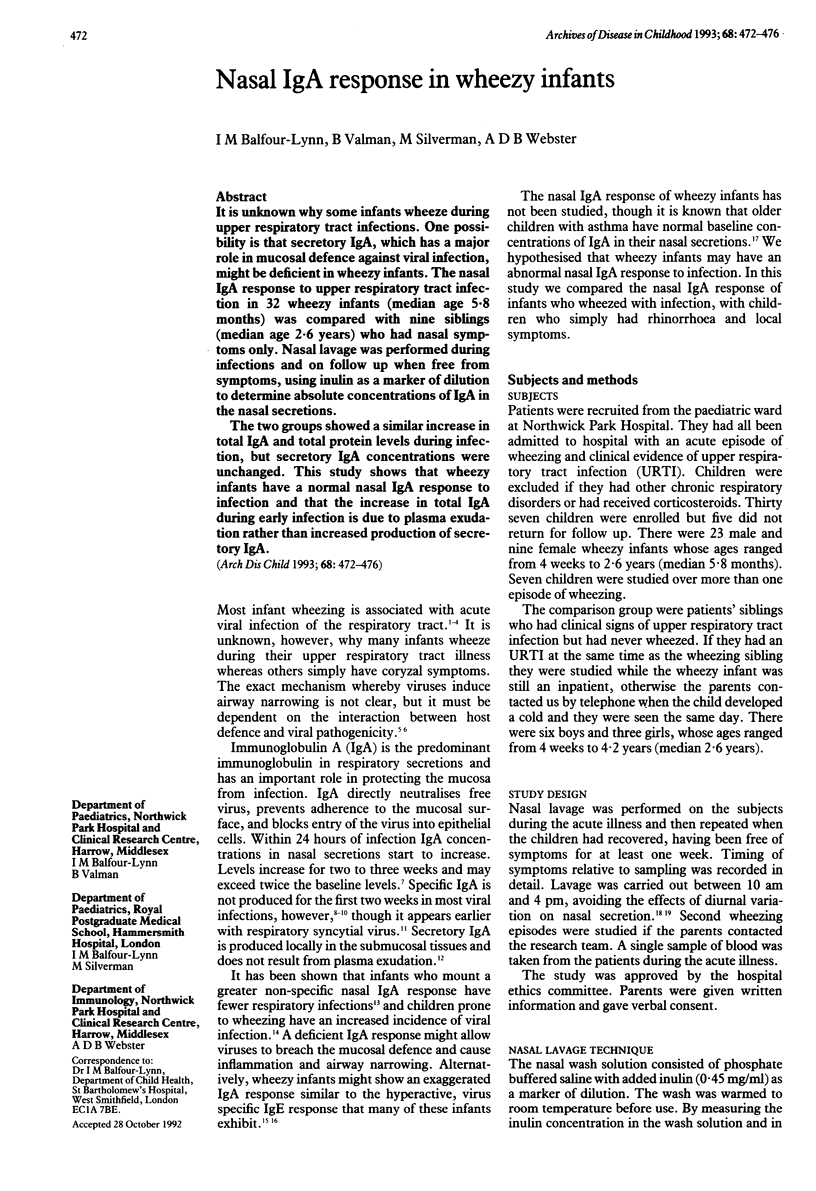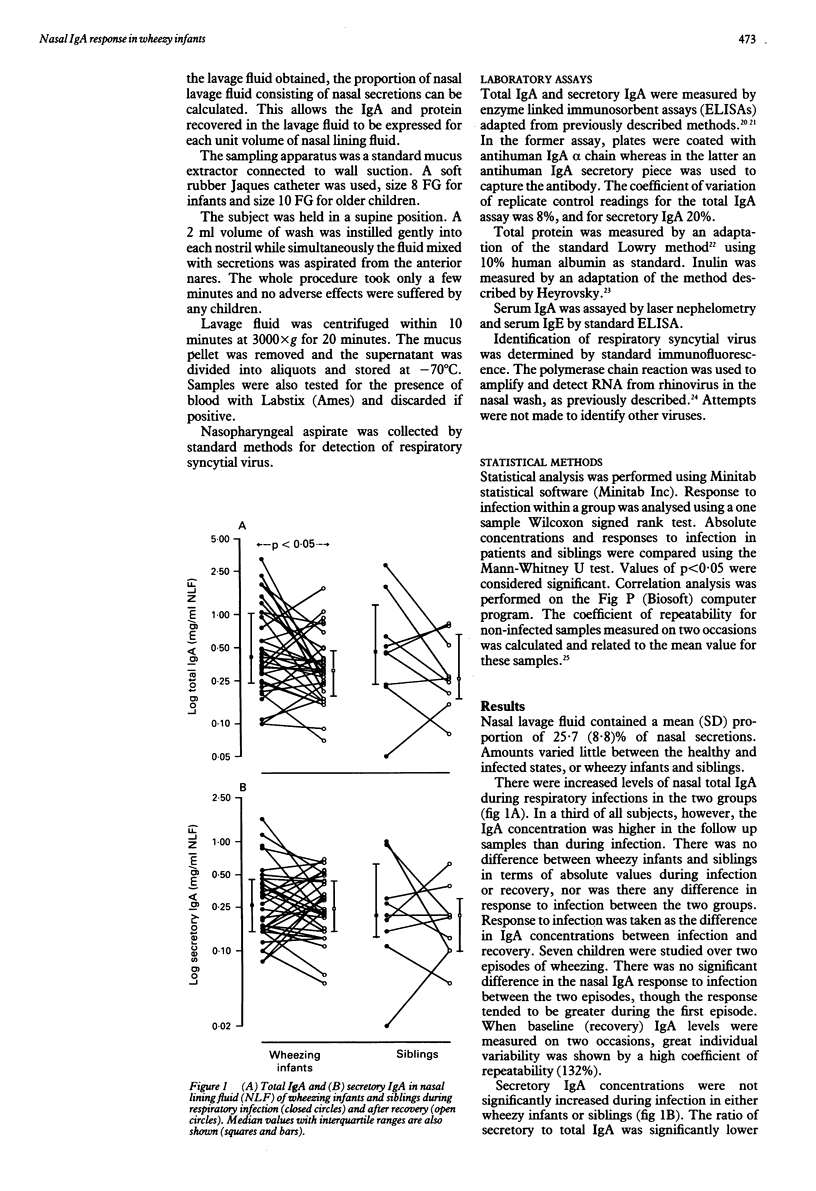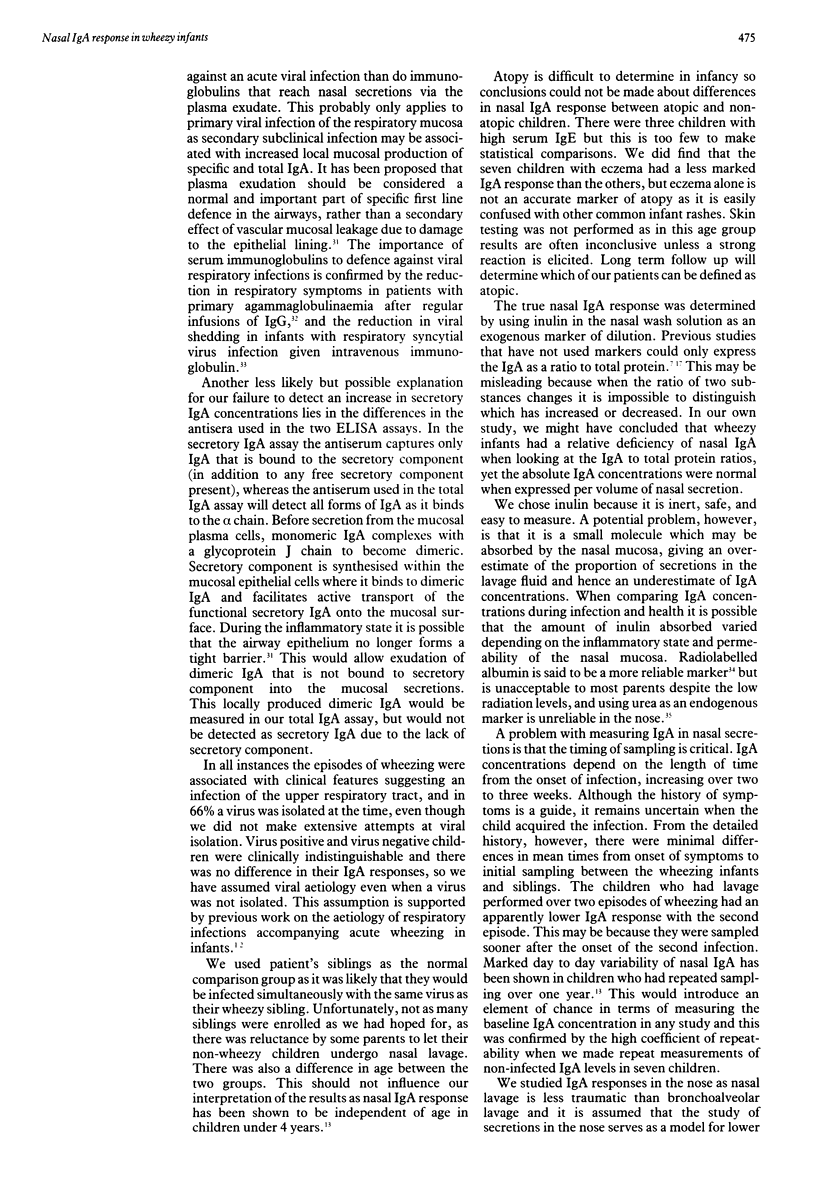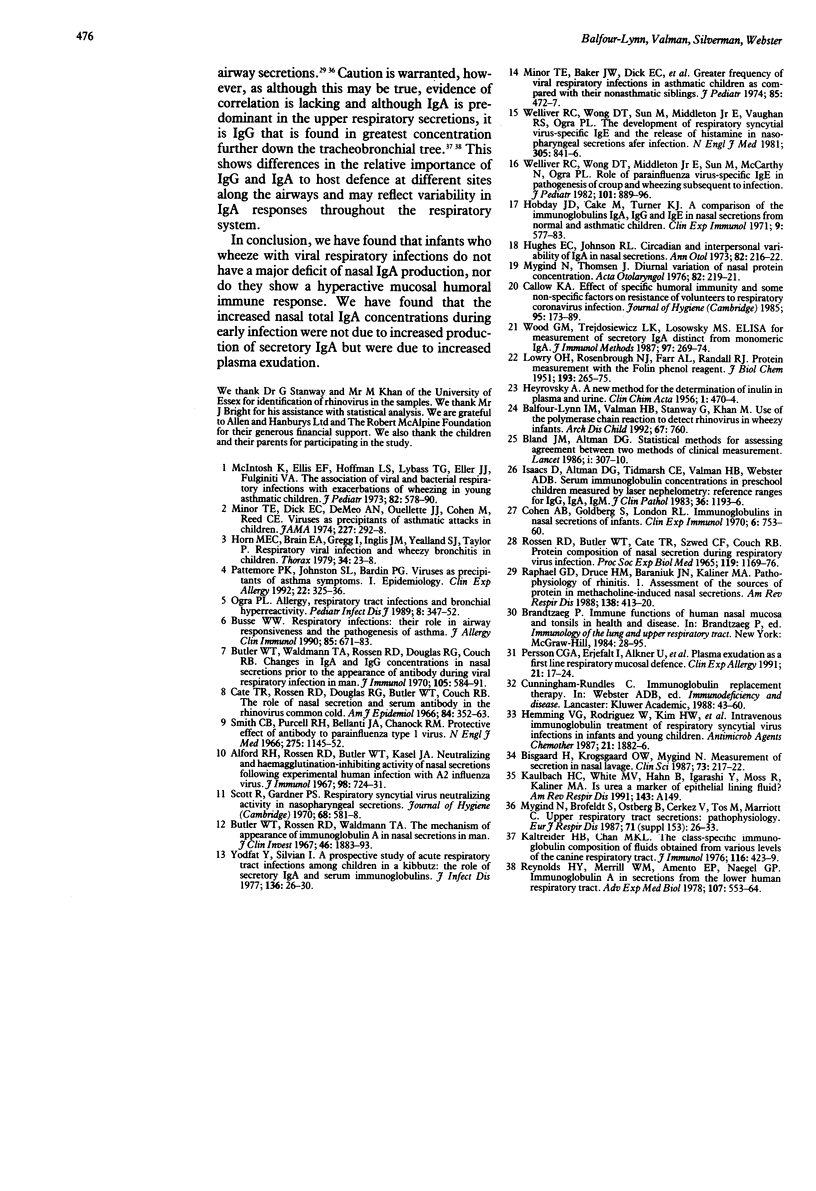Abstract
It is unknown why some infants wheeze during upper respiratory tract infections. One possibility is that secretory IgA, which has a major role in mucosal defence against viral infection, might be deficient in wheezy infants. The nasal IgA response to upper respiratory tract infection in 32 wheezy infants (median age 5.8 months) was compared with nine siblings (median age 2.6 years) who had nasal symptoms only. Nasal lavage was performed during infections and on follow up when free from symptoms, using inulin as a marker of dilution to determine absolute concentrations of IgA in the nasal secretions. The two groups showed a similar increase in total IgA and total protein levels during infection, but secretory IgA concentrations were unchanged. This study shows that wheezy infants have a normal nasal IgA response to infection and that the increase in total IgA during early infection is due to plasma exudation rather than increased production of secretory IgA.
Full text
PDF




Selected References
These references are in PubMed. This may not be the complete list of references from this article.
- Alford R. H., Rossen R. D., Butler W. T., Kasel J. A. Neutralizing and hemagglutination-inhibiting activity of nasal secretions following experimental human infection with A2 influenza virus. J Immunol. 1967 Apr;98(4):724–731. [PubMed] [Google Scholar]
- Balfour-Lynn I. M., Valman H. B., Stanway G., Khan M. Use of polymerase chain reaction to detect rhinovirus in wheezy infants. Arch Dis Child. 1992 Jun;67(6):760–760. doi: 10.1136/adc.67.6.760-b. [DOI] [PMC free article] [PubMed] [Google Scholar]
- Bisgaard H., Krogsgaard O. W., Mygind N. Measurement of secretion in nasal lavage. Clin Sci (Lond) 1987 Aug;73(2):217–222. doi: 10.1042/cs0730217. [DOI] [PubMed] [Google Scholar]
- Bland J. M., Altman D. G. Statistical methods for assessing agreement between two methods of clinical measurement. Lancet. 1986 Feb 8;1(8476):307–310. [PubMed] [Google Scholar]
- Busse W. W. Respiratory infections: their role in airway responsiveness and the pathogenesis of asthma. J Allergy Clin Immunol. 1990 Apr;85(4):671–683. doi: 10.1016/0091-6749(90)90181-3. [DOI] [PubMed] [Google Scholar]
- Butler W. T., Rossen R. D., Waldmann T. A. The mechanism of appearance of immunoglobulin A in nasal secretions in man. J Clin Invest. 1967 Dec;46(12):1883–1893. doi: 10.1172/JCI105678. [DOI] [PMC free article] [PubMed] [Google Scholar]
- Butler W. T., Waldmann T. A., Rossen R. D., Douglas R. G., Jr, Couch R. B. Changes in IgA and IgG concentrations in nasal secretions prior to the appearance of antibody during viral respiratory infection in man. J Immunol. 1970 Sep;105(3):584–591. [PubMed] [Google Scholar]
- Callow K. A. Effect of specific humoral immunity and some non-specific factors on resistance of volunteers to respiratory coronavirus infection. J Hyg (Lond) 1985 Aug;95(1):173–189. doi: 10.1017/s0022172400062410. [DOI] [PMC free article] [PubMed] [Google Scholar]
- Cate T. R., Rossen R. D., Douglas R. G., Jr, Butler W. T., Couch R. B. The role of nasal secretion and serum antibody in the rhinovirus common cold. Am J Epidemiol. 1966 Sep;84(2):352–363. doi: 10.1093/oxfordjournals.aje.a120648. [DOI] [PubMed] [Google Scholar]
- Cohen A. B., Goldberg S., London R. L. Immunoglobulins in nasal secretions of infants. Clin Exp Immunol. 1970 May;6(5):753–760. [PMC free article] [PubMed] [Google Scholar]
- HEYROVSKY A. A new method for the determination of inulin in plasma and urine. Clin Chim Acta. 1956 Sep-Oct;1(5):470–474. doi: 10.1016/0009-8981(56)90020-1. [DOI] [PubMed] [Google Scholar]
- Hemming V. G., Rodriguez W., Kim H. W., Brandt C. D., Parrott R. H., Burch B., Prince G. A., Baron P. A., Fink R. J., Reaman G. Intravenous immunoglobulin treatment of respiratory syncytial virus infections in infants and young children. Antimicrob Agents Chemother. 1987 Dec;31(12):1882–1886. doi: 10.1128/aac.31.12.1882. [DOI] [PMC free article] [PubMed] [Google Scholar]
- Hobday J. D., Cake M., Turner K. J. A comparison of the immunoglobulins IgA, IgG and IgE in nasal secretions from normal and asthmatic children. Clin Exp Immunol. 1971 Nov;9(5):577–583. [PMC free article] [PubMed] [Google Scholar]
- Horn M. E., Brain E. A., Gregg I., Inglis J. M., Yealland S. J., Taylor P. Respiratory viral infection and wheezy bronchitis in childhood. Thorax. 1979 Feb;34(1):23–28. doi: 10.1136/thx.34.1.23. [DOI] [PMC free article] [PubMed] [Google Scholar]
- Hughes E. C., Johnson R. L. Circadian and interpersonal variability of IgA in nasal secretions. Ann Otol Rhinol Laryngol. 1973 Mar-Apr;82(2):216–222. doi: 10.1177/000348947308200221. [DOI] [PubMed] [Google Scholar]
- Isaacs D., Altman D. G., Tidmarsh C. E., Valman H. B., Webster A. D. Serum immunoglobulin concentrations in preschool children measured by laser nephelometry: reference ranges for IgG, IgA, IgM. J Clin Pathol. 1983 Oct;36(10):1193–1196. doi: 10.1136/jcp.36.10.1193. [DOI] [PMC free article] [PubMed] [Google Scholar]
- Kaltreider H. B., Chan M. K. The class-specific immunoglobulin composition of fluids obtained from various levels of the canine respiratory tract. J Immunol. 1976 Feb;116(2):423–429. [PubMed] [Google Scholar]
- LOWRY O. H., ROSEBROUGH N. J., FARR A. L., RANDALL R. J. Protein measurement with the Folin phenol reagent. J Biol Chem. 1951 Nov;193(1):265–275. [PubMed] [Google Scholar]
- McIntosh K., Ellis E. F., Hoffman L. S., Lybass T. G., Eller J. J., Fulginiti V. A. The association of viral and bacterial respiratory infections with exacerbations of wheezing in young asthmatic children. J Pediatr. 1973 Apr;82(4):578–590. doi: 10.1016/S0022-3476(73)80582-7. [DOI] [PMC free article] [PubMed] [Google Scholar]
- Minor T. E., Baker J. W., Dick E. C., DeMeo A. N., Ouellette J. J., Cohen M., Reed C. E. Greater frequency of viral respiratory infections in asthmatic children as compared with their nonasthmatic siblings. J Pediatr. 1974 Oct;85(4):472–477. doi: 10.1016/S0022-3476(74)80447-6. [DOI] [PMC free article] [PubMed] [Google Scholar]
- Minor T. E., Dick E. C., DeMeo A. N., Ouellette J. J., Cohen M., Reed C. E. Viruses as precipitants of asthmatic attacks in children. JAMA. 1974 Jan 21;227(3):292–298. [PubMed] [Google Scholar]
- Mygind N., Brofeldt S., Ostberg B., Cerkez V., Tos M., Marriott C. Upper respiratory tract secretions: pathophysiology. Eur J Respir Dis Suppl. 1987;153:26–33. [PubMed] [Google Scholar]
- Mygind N., Thomsen J. Diurnal variation of nasal protein concentration. Acta Otolaryngol. 1976 Sep-Oct;82(3-4):219–221. doi: 10.3109/00016487609120888. [DOI] [PubMed] [Google Scholar]
- Ogra P. L. Allergy, respiratory tract infections and bronchial hyperreactivity. Pediatr Infect Dis J. 1989 Jun;8(6):347–352. doi: 10.1097/00006454-198906000-00003. [DOI] [PubMed] [Google Scholar]
- Pattemore P. K., Johnston S. L., Bardin P. G. Viruses as precipitants of asthma symptoms. I. Epidemiology. Clin Exp Allergy. 1992 Mar;22(3):325–336. doi: 10.1111/j.1365-2222.1992.tb03094.x. [DOI] [PMC free article] [PubMed] [Google Scholar]
- Persson C. G., Erjefält I., Alkner U., Baumgarten C., Greiff L., Gustafsson B., Luts A., Pipkorn U., Sundler F., Svensson C. Plasma exudation as a first line respiratory mucosal defence. Clin Exp Allergy. 1991 Jan;21(1):17–24. doi: 10.1111/j.1365-2222.1991.tb00799.x. [DOI] [PubMed] [Google Scholar]
- Raphael G. D., Druce H. M., Baraniuk J. N., Kaliner M. A. Pathophysiology of rhinitis. 1. Assessment of the sources of protein in methacholine-induced nasal secretions. Am Rev Respir Dis. 1988 Aug;138(2):413–420. doi: 10.1164/ajrccm/138.2.413. [DOI] [PubMed] [Google Scholar]
- Reynolds H. Y., Merrill W. M., Amento E. P., Naegel G. P. Immunoglobulin A in secretions from the lower human respiratory tract. Adv Exp Med Biol. 1978;107:553–564. doi: 10.1007/978-1-4684-3369-2_63. [DOI] [PubMed] [Google Scholar]
- Rossen R. D., Butler W. T., Cate T. R., Szwed C. F., Couch R. B. Protein composition of nasal secretion during respiratory virus infection. Proc Soc Exp Biol Med. 1965 Aug-Sep;119(4):1169–1176. doi: 10.3181/00379727-119-30406. [DOI] [PubMed] [Google Scholar]
- Scott R., Gardner P. S. Respiratory syncytial virus neutralizing activity in nasopharyngeal secretions. J Hyg (Lond) 1970 Dec;68(4):581–588. doi: 10.1017/s0022172400042510. [DOI] [PMC free article] [PubMed] [Google Scholar]
- Smith C. B., Purcell R. H., Bellanti J. A., Chanock R. M. Protective effect of antibody to parainfluenza type 1 virus. N Engl J Med. 1966 Nov 24;275(21):1145–1152. doi: 10.1056/NEJM196611242752101. [DOI] [PubMed] [Google Scholar]
- Welliver R. C., Wong D. T., Middleton E., Jr, Sun M., McCarthy N., Ogra P. L. Role of parainfluenza virus-specific IgE in pathogenesis of croup and wheezing subsequent to infection. J Pediatr. 1982 Dec;101(6):889–896. doi: 10.1016/s0022-3476(82)80005-x. [DOI] [PubMed] [Google Scholar]
- Welliver R. C., Wong D. T., Sun M., Middleton E., Jr, Vaughan R. S., Ogra P. L. The development of respiratory syncytial virus-specific IgE and the release of histamine in nasopharyngeal secretions after infection. N Engl J Med. 1981 Oct 8;305(15):841–846. doi: 10.1056/NEJM198110083051501. [DOI] [PubMed] [Google Scholar]
- Wood G. M., Trejdosiewicz L. K., Losowsky M. S. ELISA for measurement of secretory IgA distinct from monomeric IgA. J Immunol Methods. 1987 Mar 12;97(2):269–274. doi: 10.1016/0022-1759(87)90470-4. [DOI] [PubMed] [Google Scholar]
- Yodfat Y., Silvian I. A prospective study of acute respiratory tract infections among children in a kibbutz: the role of secretory IgA and serum immunoglobulins. J Infect Dis. 1977 Jul;136(1):26–30. doi: 10.1093/infdis/136.1.26. [DOI] [PubMed] [Google Scholar]


